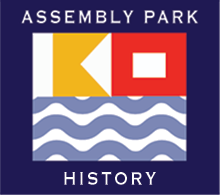Click on the photo to see larger view.
1900
1901
• By 1901, the Assembly programs were known throughout the Midwest for their outstanding 10-day sessions.
1902
• Tents provided lodging during the first years on Assembly grounds. They could be rented or you could bring your own. There were so many tents the first years that the event was referred to in newspaper articles as "The White City."
1903
• Bird's eye view of the Park - How the park looked about 1903 when it was said that there were about fifty cottages. The auditorium, dining hall and water tower were at the top of the park. There was a path that ran along the shore and a road a little further in. That small building at the beginning of the longer pier may have been the first gazebo and can be seen in other pictures of the shoreline.
• Cottage owners objected to plans to build a barn to house the horses of people attending the Chautauquas. They thought the stench of the manure would be overpowering.
• Delavan Lake Assembly Association, sold lots by 1903 over 50 cottages had been erected.
World Events
Presidents
• William McKinley • Theodore Roosevelt • William H. Taft
1900
• Hawaii becomes an official U.S. territory.
1901
1902
1903
1904
1905
1906
1907
1908
1909
1904
• The roof on this very old version of the gazebo seems to be the same as that on the gazebo that was replaced.
• Perhaps what appears to be walls were actually curtains and it was used for a changing room.
• Then at some time this gazebo was moved back from the shoreline to the current gazebo location.
• Date photo unknown.
• In 1904, William Jennings Bryant was featured and spoke to a crowd of 4,000.
• A very large sign like this was used to show the way to the Delavan Lake Assembly.
• Two-week sessions were held in late July and early August.
• Chautauqua programs were held in the 3,500-seat Assembly auditorium between 1898 and 1914.
1905
1906
• The Snyder/Bestul family has resided here from the beginning. The above photo was of the house built in 1906 at 1119 N. Gazebo. (unknown date)













